 With heads tilted and mouths agape at the abundance of banana bunches ready for harvest, visitors wandered the demo farms of the Department of Science and Technology-Philippine Council for Agriculture, Aquatic and Natural Resources Research and Development (PCAARRD)-funded project “Adoption of Science and Technology (S&T)-based Integrated Crop Management and Good Agricultural Practices for Cardaba Banana in Caraga Region”.
With heads tilted and mouths agape at the abundance of banana bunches ready for harvest, visitors wandered the demo farms of the Department of Science and Technology-Philippine Council for Agriculture, Aquatic and Natural Resources Research and Development (PCAARRD)-funded project “Adoption of Science and Technology (S&T)-based Integrated Crop Management and Good Agricultural Practices for Cardaba Banana in Caraga Region”.
The visitors were participants to the field day held at Barangay Tiniwisan in Butuan City on October 14.
“The technology works!” exclaimed Demetrio E. Tabelon, farmer-cooperator and barangay captain of Barangay Tiniwisan. He, along with Julius S. Legaspo and Severino Garrido, are partnering with the Caraga State University (CSU) under the leadership of Dr. Rowena Varela and PCAARRD’s Crop Research Division to showcase the package of technology for producing Cardaba banana.
Cardaba is grown in smallhold farms in Mindanao and is sold primarily to banana chip processors. Mindanao’s existing banana chip factories require raw material from at least 30,000 hectares annually (GEM, 2007). With the prevalence of smallholds averaging one hectare or less, raw material production can potentially provide income for 30,000─50,000 banana farmers from all over Mindanao.
The Celebes Agricultural Corporation produces 90 containers of banana chips every month and is one of the country’s largest export-oriented enterprises dealing with coconut products and banana chips. Everyday, its Butuan City plant alone requires 40 metric tons. Only 20% is currently supplied by growers in the city and the immediate vicinity.
 This demand alone justifies the intensification of Cardaba production to supply the required volume. With its wide areas suitable for production and its favorable climate, the Caraga Region has a vast potential to produce the required volume of the banana.
This demand alone justifies the intensification of Cardaba production to supply the required volume. With its wide areas suitable for production and its favorable climate, the Caraga Region has a vast potential to produce the required volume of the banana.
To move beyond smallhold farm practices and ensure the productivity of the plantations, S&T-based interventions were introduced through demonstration farms. The basic technologies include planting tissue-cultured Cardaba plantlets and the technology package developed by the University of the Philippines Los Baños, Bureau of Plant Industry in Davao City, and other research and development institutions. These technologies cover practices for crop production and disease management. Crop management measures include clean culture and disease management include measures to prevent the bugtok disease ––– a common problem in smallhold Cardaba farms in the area.
The field day was held in cooperation with the Caraga Consortium for Agriculture and Resources Research and Development. It was likewise highlighted by a training/seminar on Cardaba banana and the sharing of experiences by the farmer-cooperators of the program – Tabelon and Legaspo for the package of technology on production and plantation establishment, and Garrido for rehabilitation of old plantations.
